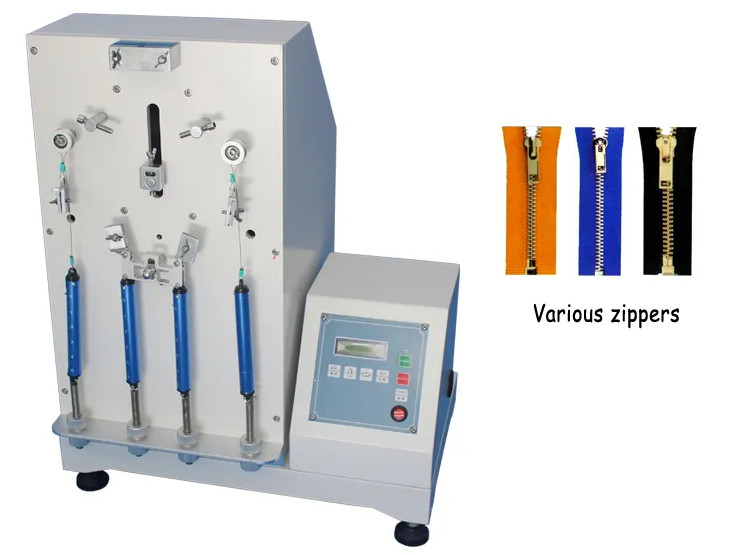Plastic zipper reciprocating fatigue test equipment
Plastic zipper reciprocating fatigue test equipment is a specialized machine designed to evaluate the durability and performance of plastic zippers under repeated opening and closing cycles. This type of test equipment has become increasingly important in industries such as apparel, outdoor gear, and automotive, where plastic zippers are commonly used. In this discussion, we will explore the purpose, operation, key features, and benefits of plastic zipper reciprocating fatigue test equipment.
1. Purpose of Plastic Zipper Reciprocating Fatigue Test Equipment:
The main purpose of plastic zipper reciprocating fatigue testing is to assess the endurance and longevity of plastic zippers subjected to cyclic operations. Plastic zippers are widely used due to their lightweight, corrosion resistance, and ease of maintenance. However, they must withstand continuous use without failure or degradation. The test equipment simulates real-world usage conditions by subjecting plastic zippers to repetitive opening and closing cycles, enabling manufacturers to evaluate their performance, identify potential failure modes, and ensure compliance with industry standards.
2. Operation of Plastic Zipper Reciprocating Fatigue Test Equipment:
Plastic zipper reciprocating fatigue test equipment typically consists of the following components:
a. Test Chamber: It provides a controlled environment for the test and securely holds the plastic zipper specimen.
b. Reciprocating Mechanism: This mechanism generates the reciprocating motion necessary to simulate the opening and closing cycles of the zipper. It usually consists of a motor, drive system, and a mechanism to hold and manipulate the zipper slider.

c. Load Application System: The equipment applies a specific load or tension to the zipper during the test to mimic realistic conditions.
d. Speed Control: The equipment allows for adjustable speed control, which enables users to mimic different usage scenarios and cycle speeds. This feature ensures that the test accurately represents real-world conditions.
e. Cycle Counter: The equipment is equipped with a cycle counter that records the number of opening and closing cycles completed during the test. This information is valuable for assessing the durability and fatigue life of the plastic zipper.
f. Safety Measures: Plastic zipper reciprocating fatigue test equipment often incorporates safety measures to prevent accidents or damage. This may include emergency stop buttons, overload protection, and safety guards to ensure operator safety.
3. Key Features of Plastic Zipper Reciprocating Fatigue Test Equipment:
Below are some key features commonly found in plastic zipper reciprocating fatigue test equipment:
a. Programmable Control: The equipment allows users to set specific test parameters such as cycle count, speed, and load conditions. This programmable control feature enhances flexibility and repeatability in testing.
b. Real-Time Monitoring: Test equipment may have a display or a computer interface that provides real-time monitoring of test progress, cycle count, and any abnormalities or failures observed during the test.
c. Data Recording and Analysis: Many plastic zipper reciprocating fatigue test equipment can record and store test data for further analysis. This feature facilitates performance evaluation, quality control, and comparison between different samples or batches.
d. Compliance with Standards: Test equipment often complies with industry standards such as ASTM, ISO, or specific manufacturer requirements. This ensures that the test results are reliable and can be compared to industry benchmarks.
e. Customization: Some manufacturers offer customization options to tailor the test equipment to specific testing needs. This may include variability in test speed, load applications, or design modifications to accommodate different zipper types.
4. Benefits of Plastic Zipper Reciprocating Fatigue Test Equipment:
Using plastic zipper reciprocating fatigue test equipment offers several benefits for manufacturers:
a. Quality Control: The equipment helps ensure that plastic zippers meet quality standards before they are used in production. By identifying potential failure modes early on, manufacturers can make necessary design or material improvements to enhance the zipper's reliability.
b. Performance Evaluation: The test equipment provides quantitative data on the durability and fatigue life of plastic zippers. This information allows manufacturers to assess the performance of different zipper designs, materials, or manufacturing processes and make informed decisions for product improvement.
c. Cost Savings: By identifying potential zipper failures during the testing phase, manufacturers can reduce the risk of product recalls, warranty claims, or customer dissatisfaction. This ultimately leads to cost savings by avoiding expensive rework, potential legal liabilities, or negative brand reputation.
d. Market Competitiveness: High-quality plastic zippers that have undergone rigorous testing and meet industry standards can give manufacturers a competitive edge. They can market their products as durable and reliable, appealing to consumers who value longevity and performance.
e. Continuous Improvement: Analysis of test data allows manufacturers to identify areas for improvement in zipper design, material selection, or manufacturing processes. This iterative approach enables continuous improvement in product quality and performance.
In summary, plastic zipper reciprocating fatigue test equipment is a crucial tool for evaluating the durability and performance of plastic zippers. By subjecting zippers to repeated opening and closing cycles, manufacturers can ensure their products meet quality standards, enhance performance, and deliver long-lasting value to customers.

